Gibson introduced its most revolutionary instrument in 1958, the ES-335. It boasted a sleek, thin, double-cutaway body, but even more interesting was what was hidden inside. A solid block in the otherwise hollow body created a new semi-solid structure, aiming to combine the qualities of a hollowbody guitar and a solidbody.
Gibson soon built a series upon it, adding the stereo ES-345, the high-end ES-355, and the hollow ES-330, and players have lined up ever since to exploit the unique tones and classic vibe of the 300s family.
Gibson produced many different models within and around this family through the decades since those originals first appeared in the late '50s, and in this timeline we've detailed some of the most important, interesting, and unusual models and variations. (For space reasons we've omitted signature models, limited runs, and guitars made in Gibson's Nashville Custom Shop.)
A note about Memphis: Gibson opened its new Memphis factory in May 2000, and it became the location for production of ES models. At first it was part of the USA division.
From 2005 to 2013, Memphis became part of Gibson's Custom Shop division. Confusingly, during that '05–'13 period, some instruments produced at Memphis had Custom Shop markings and CS-prefix serial numbers. However, Memphis was never a Custom Shop—Gibson's only Custom Shop was and is located at its Nashville plant.
In 2013, Memphis was made an independent division, but in 2018 Gibson sold and closed the factory, and ES production returned to the brand's Nashville plant.

Gibson's revolutionary semi-solid design began here: Double-cutaway hollow laminated maple 16-inch-wide body with internal solid maple center-block, single-bound top and back; mahogany neck; rosewood fingerboard with dot markers; four knobs (volume and tone per pickup) on body with selector and jack; black pickguard; two humbuckers; Tune-o-matic bridge plus separate stopbar or vibrato; nickel-plated metalwork.
Officially named ES-335T or 335TD (sunburst finish) and 335TN or 335TDN (natural), adding from '61 335TDC (cherry). Changes included a bound fingerboard (from late '58) and a shorter pickguard not extending beyond the bridge (from late '60).
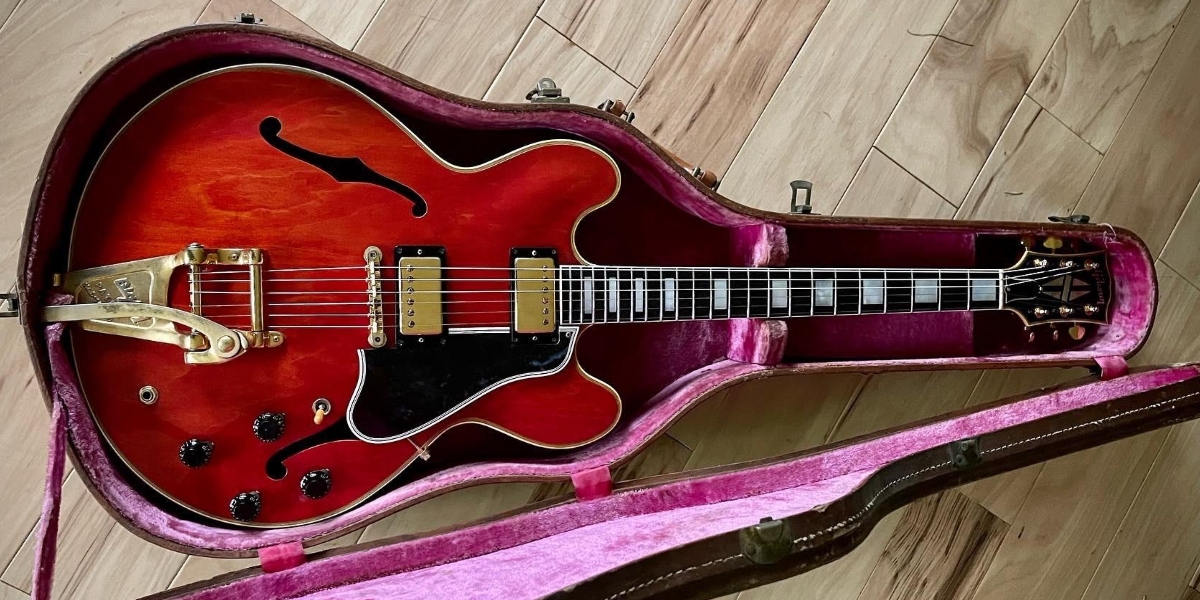
High-end take on the 335 semi-solid style: Multi-bound body top, triple-bound back; ebony board with block markers; split-diamond inlay on bound headstock; two humbuckers; Tune-o-matic bridge plus separate vibrato; gold-plated metalwork.
Mono: four knobs (volume and tone per pickup) on body with selector and mono-wired jack (355TD). Stereo: four knobs on body with selector, stereo-wired jack, six-way Varitone selector (355TDSV), or without Varitone (355TDS '79–'80).
Changes include: shorter pickguard not extending beyond bridge (from late '60); fingerboard width at nut reduced from 1 11/16 to 1 9/16 inches ('66–'75); rear neck/head volute (from '69); maple neck (from '75); fine-tuning tailpiece ('79–'80).
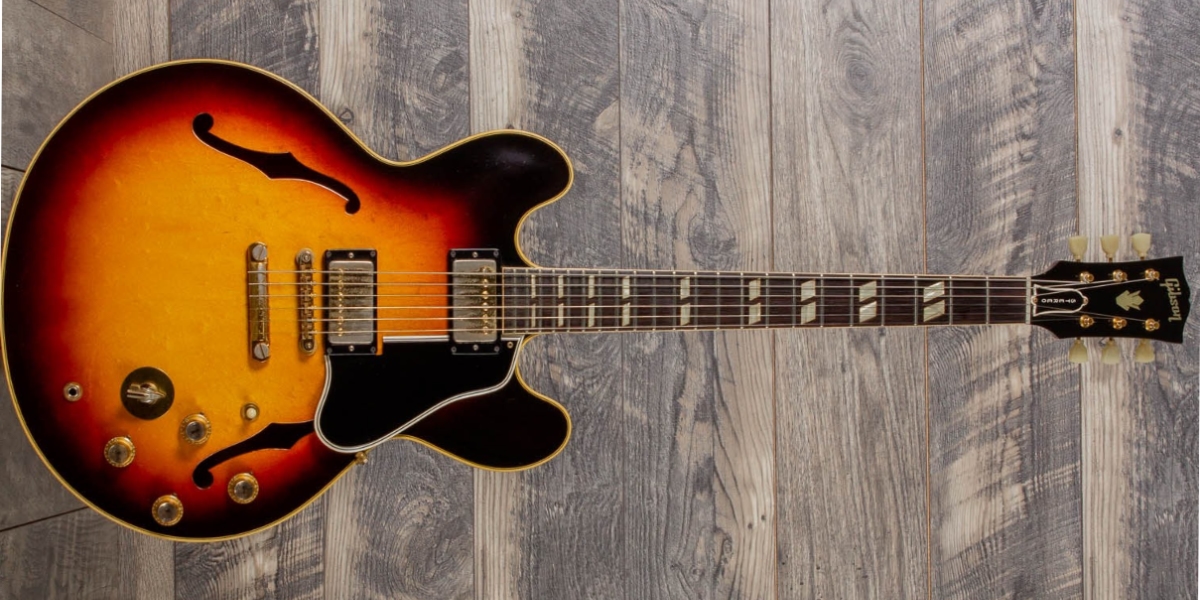
Stereo semi-solid model positioned between regular 335 and high-end 355: Triple-bound body top, single-bound back; rosewood board with double-parallelogram markers (a.k.a. twin angled blocks); crown inlay on headstock; four knobs (volume and tone per pickup) on body with selector, stereo-wired jack, six-way Varitone selector; two humbuckers; Tune-o-matic bridge plus separate stopbar or vibrato; gold-plated metalwork.
Changes include: shorter pickguard not extending beyond bridge (from late '60); trapeze tailpiece (from '65); fingerboard width at nut reduced from 1 11/16 to 1 9/16 inches ('66–'78); rear neck/head volute (from '69); maple neck (from '75). At first, officially named ES-345TDC (cherry finish) and 345TD (sunburst), adding 345TDN (natural, '59–'60).
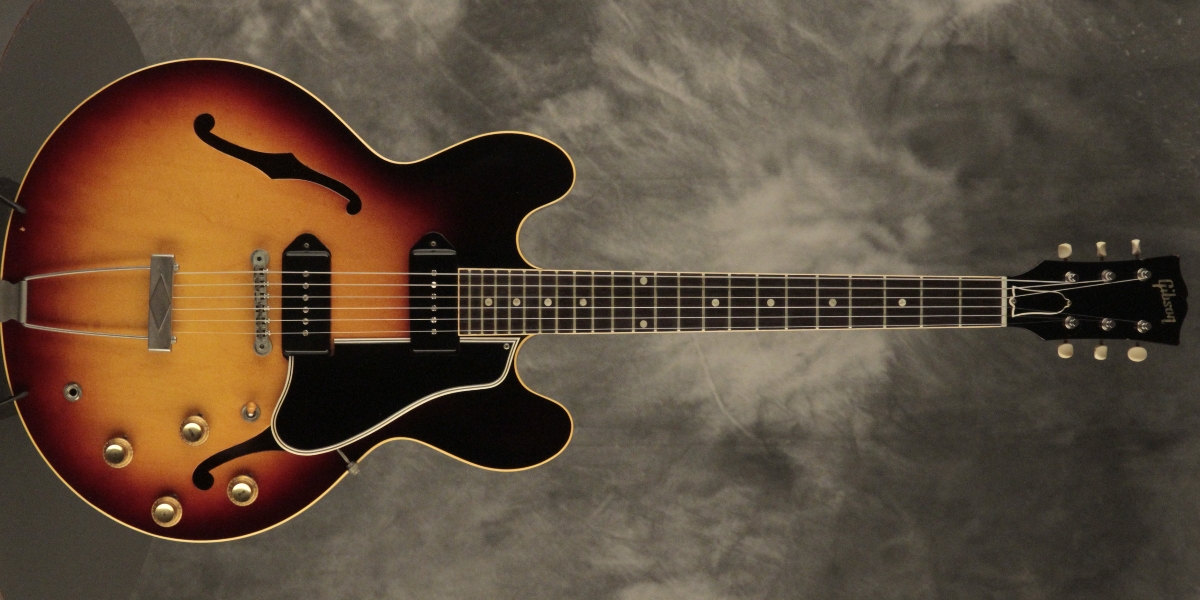
Fully hollow 335-shape model without internal center-block: Hollow laminated maple body; mahogany neck joins body at 17th fret; rosewood board with dot markers; four-knob control layout; black pickguard; two black-plastic P-90s; Tune-o-matic bridge plus separate trapeze tailpiece; nickel-plated hardware.
Changes include: neck shifted further out to join body at 19th fret (from '68); fingerboard width at nut reduced from 1 11/16 to 1 9/16 inches (from '66); small-block markers (from '62); metal P-90s (from '63). At first, officially named ES-330TD (sunburst finish) and 330TDN (natural, '59–'60), adding from '61 330TDC (cherry).
*Also: ES-330 single pickup (1959–63) Version with one P-90, two knobs, no selector; officially named ES-330T (sunburst), 330TN (natural), 330TC (cherry).
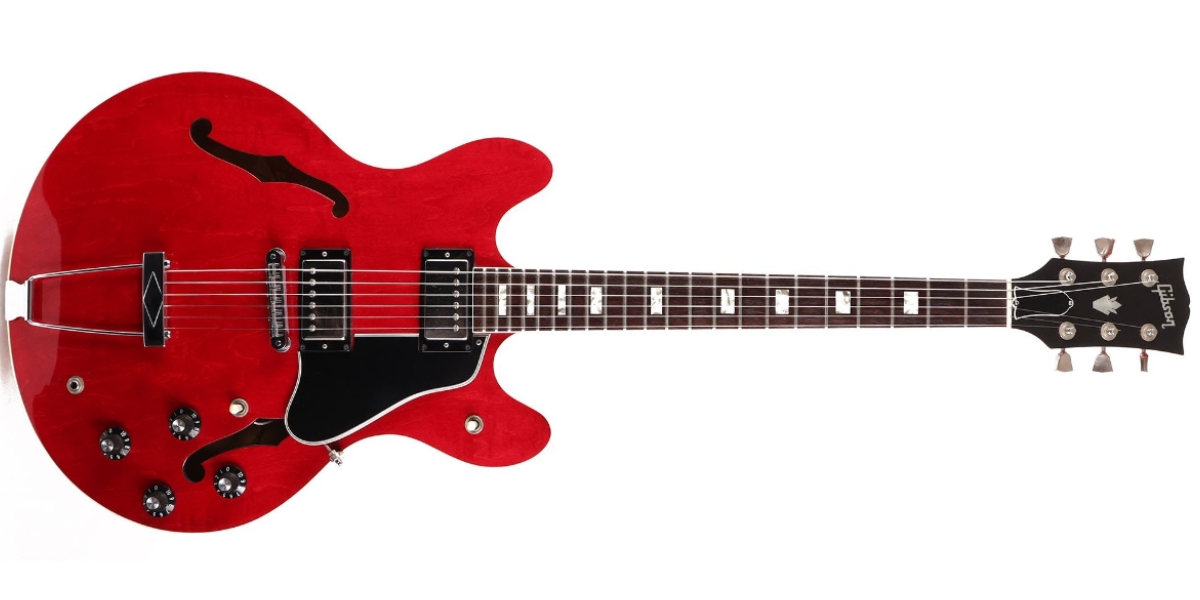
The '60s & '70s 335, most easily ID'd by small-block markers: Changes during this period included trapeze tailpiece (from '65); fingerboard width at nut reduced from 1 11/16 to 1 9/16 inches ('66–'78); volute "lump" at rear neck/head junction (from '69); maple neck (from '75); coil-tap switch (from '76).
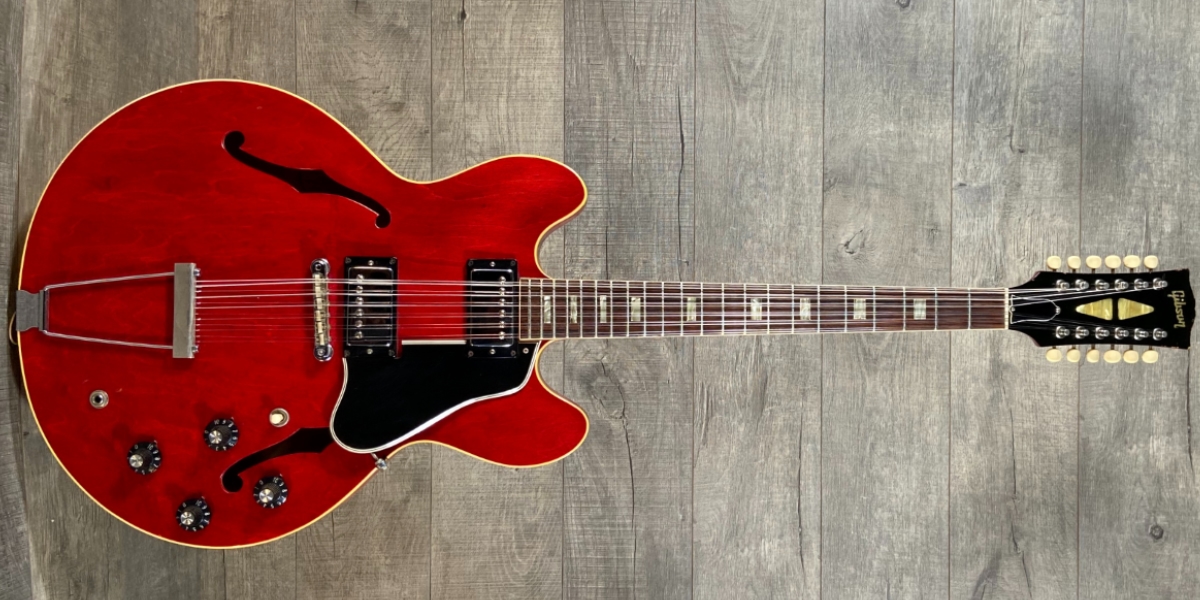
Twelve-string 335: Small-block markers; split-diamond inlay on headstock; two humbuckers; bridge with six double-notched saddles plus separate trapeze tailpiece.

High-end model: Fully hollow rosewood body, 330-style without center-block; neck joins body at 15th fret; block markers; split-diamond inlay on bound headstock; jack on body side; rosewood pickguard; two floating mini-humbuckers; rosewood bridge plus separate trapeze tailpiece with inlaid model name; gold-plated metalwork (some silver-plated).
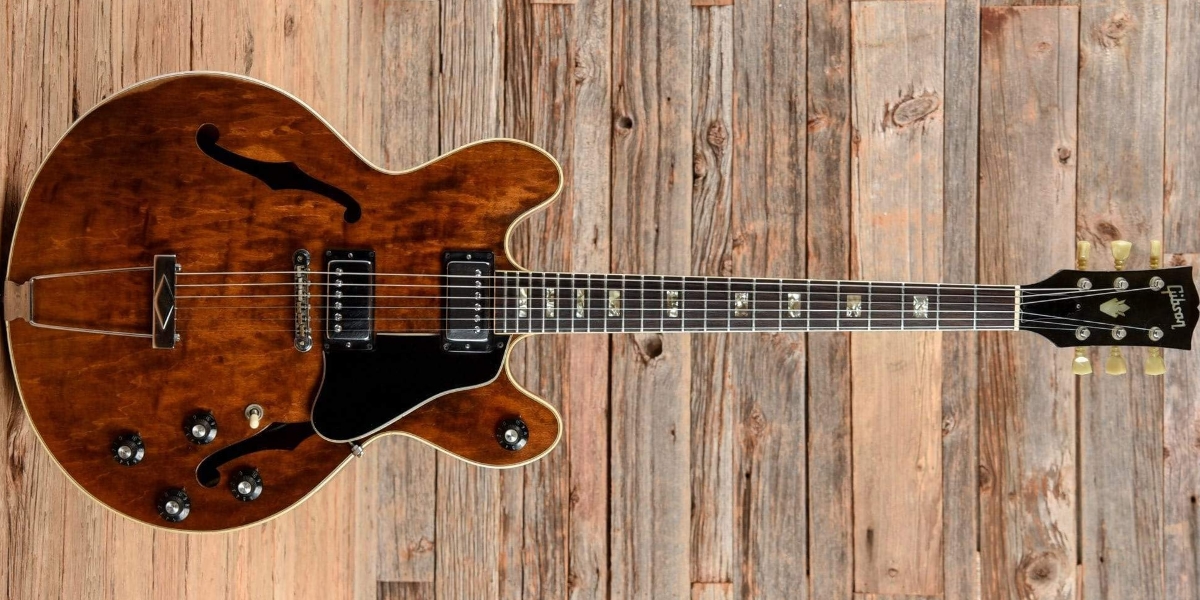
Full-depth hollow body with 335-style outline: Small-block markers; extra master volume knob on lower cutaway; jack on body side.
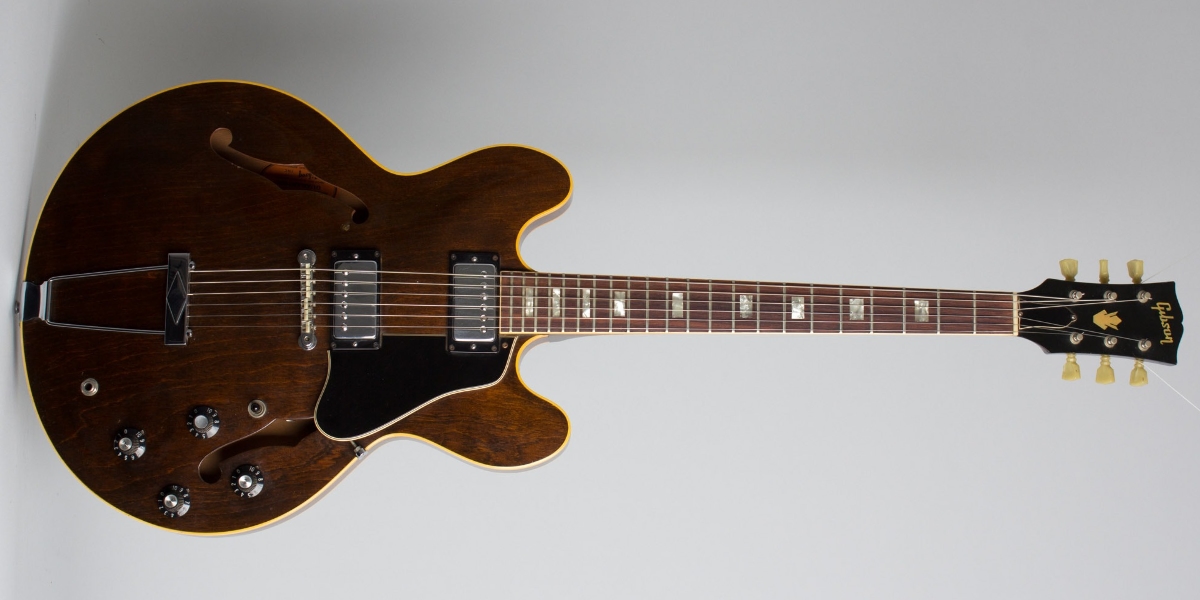
Birch-body 335-style with blend and phase controls: Hollow laminated birch body with internal solid maple center-block; maple neck; small-block markers; crown inlay on headstock; four knobs (volume, pickup-blend, two tone), selector (pickups off; pickups on in-phase; pickups on out-of-phase), jack on body; two humbuckers; bridge plus separate trapeze tailpiece.
(A few 335s were made with laminated birch bodies just before the ES-340 was introduced.)
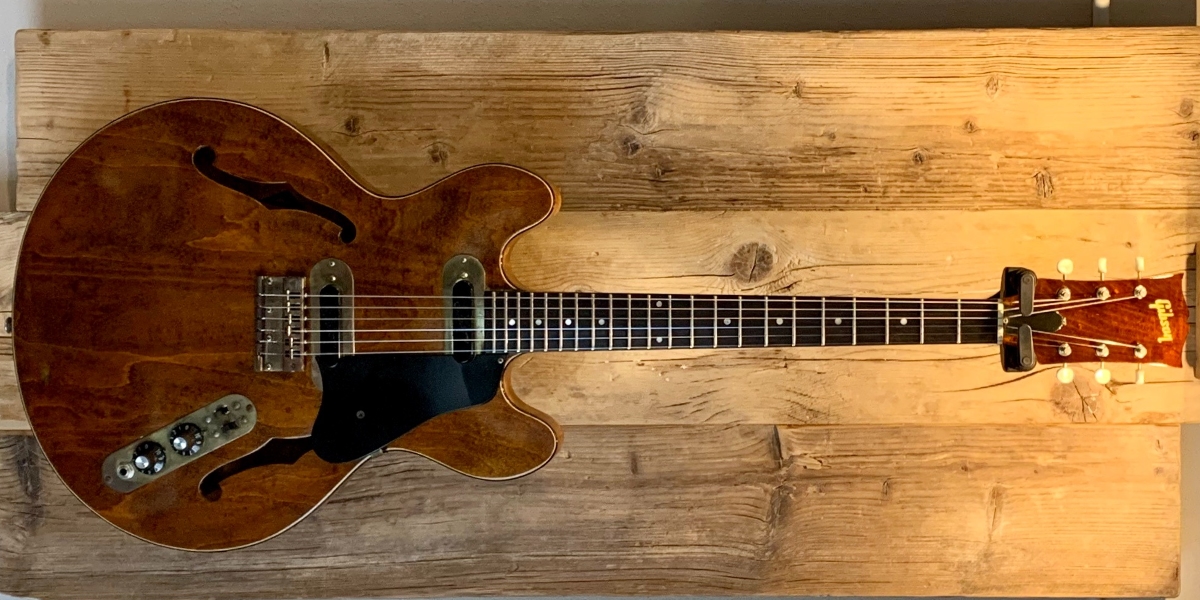
Norlin-era low-end model with center-block (sometimes not full block): Maple neck; dot markers on unbound board; angled metal control strip with two knobs (volume, tone), two two-way switches (pickups), jack; black pickguard; two black-plastic single-coils; combined bridge/tailpiece with cover.
*Also: ES-325TD (1972–77) Similar to 320 but two mini-humbuckers; bridge plus separate trapeze; semi-circular control plate with four knobs (volume and tone per pickup), selector, jack.

Higher-end 335-style model: Maple neck; block markers on bound ebony board; brass nut; four knobs (volume and tone per pickup) on body with selector, coil-tap switch, jack; two humbuckers; bridge set in brass studs plus separate fine-tuning tailpiece or vibrato; gold-plated metalwork (nickel or chrome-plated options). Also known as ES-347S.
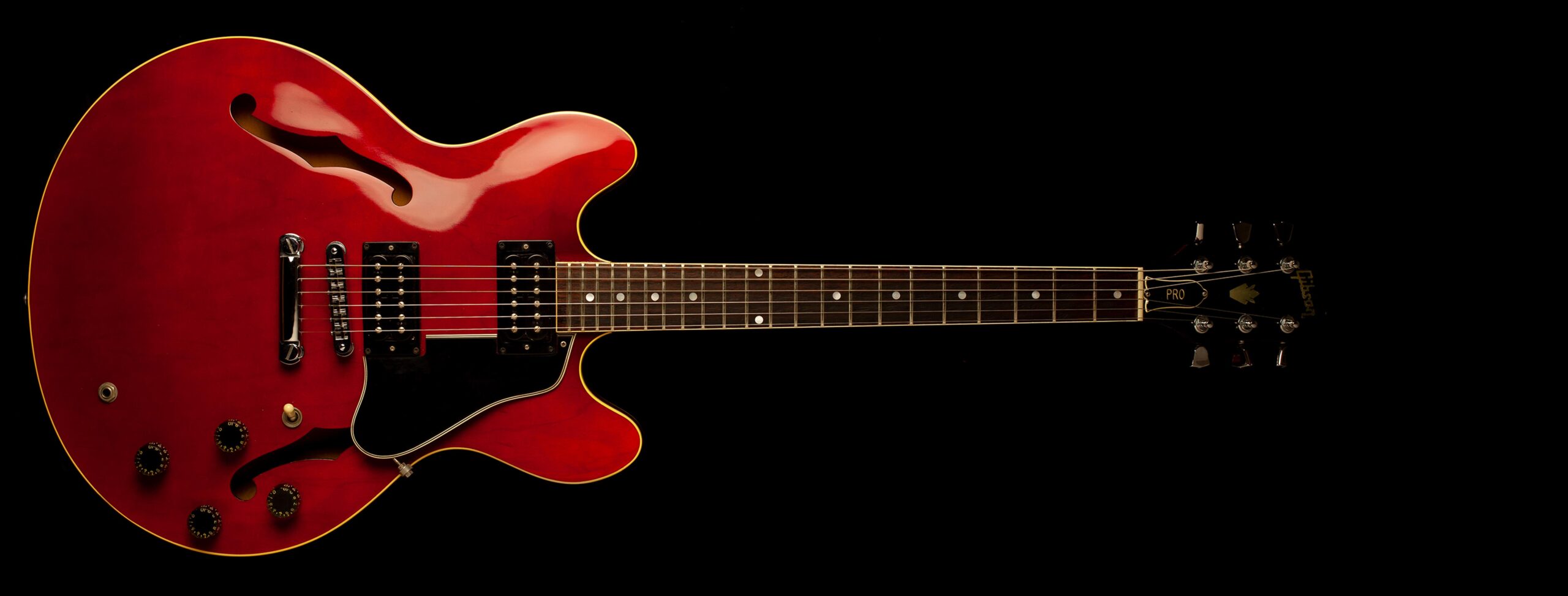
Early and shortlived revival of dot markers: High-output coverless humbuckers; bridge plus stopbar or fine-tuning tailpiece.
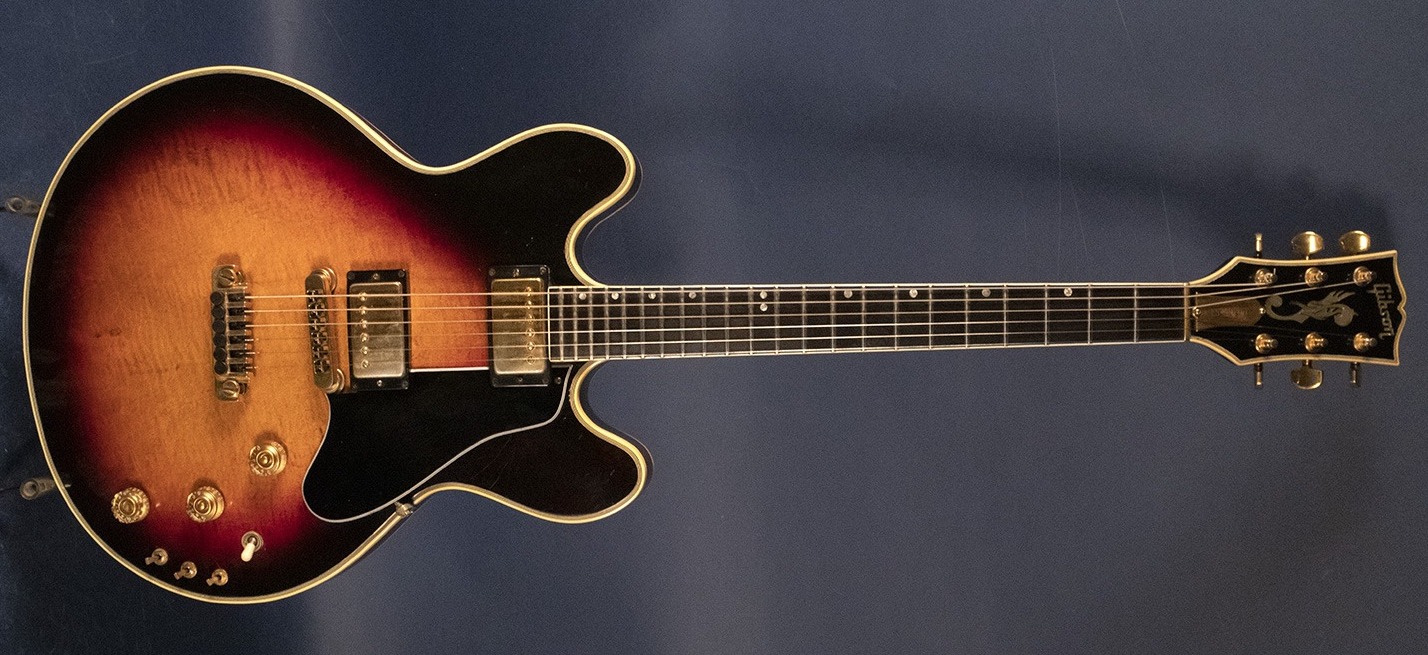
High-end semi-solid with onboard electronics: Multi-bound figured-maple body top and back, no f-holes; access plate for electronics on body rear; maple neck; ebony board with offset dot markers; fancy inlay on headstock; brass nut; three knobs (volume, bass, treble) on body with selector and three two-position mini-switches (bright on/off; compression/expansion; active on/off); jack on body side; black or tortoiseshell pickguard; two humbuckers; bridge set in brass studs plus separate fine-tuning tailpiece or vibrato; gold-plated metalwork.
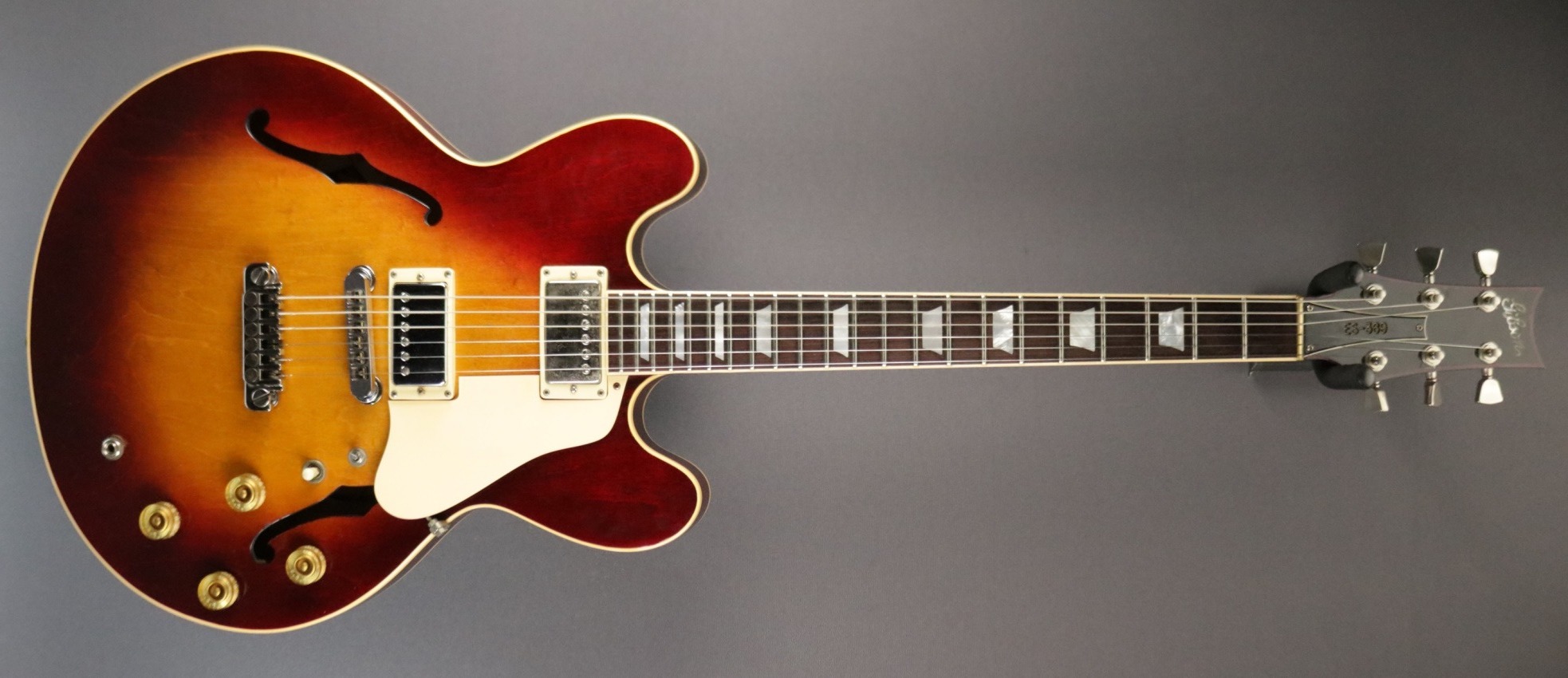
Shortlived 335-style model with Gibson Mark-like headstock: crown markers; tapered red-bound headstock; brass nut; coil-tap switch; fine-tuning tailpiece.
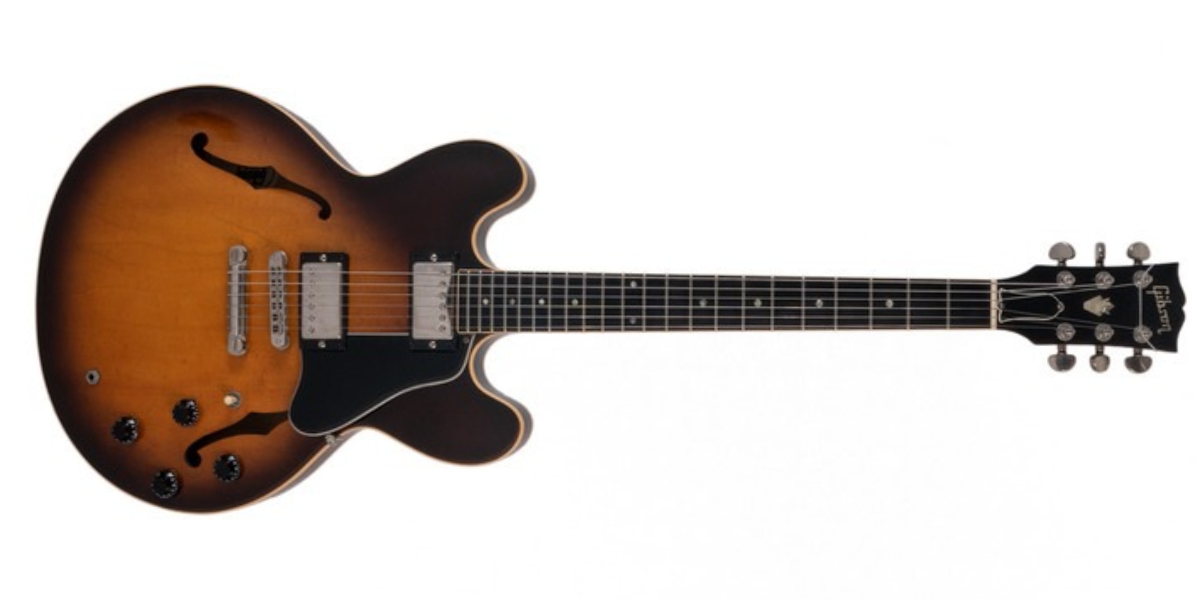
Reissue of early-style dot-neck 335: Classic features include laminated maple body with maple center-block; dot markers; four-knob control layout; shorter pickguard; two humbuckers; bridge plus separate stopbar or vibrato. Officially called ES-335 Dot (1981–89), ES-335 Reissue (1990–2000).
Gibson's Memphis factory settled on three main 335 Dot Reissue models: Regular top, gloss finish (2001–19); Regular top, satin finish (2005–19); Figured top, gloss finish (2005–19). Memphis also produced year-specific dot-neck 335s: 1960 50th Anniversary VOS (2010); 1959 ES-335 VOS (2013–19); 1958 ES-335 VOS (2016–19). ES production reverted to Nashville during 2019 after Memphis closed.
*Also: ES-335 Gothic (1998–2000) Black finish and metalwork; moon-and-star at 12th-fret only marker; ES-335 Diamond Edition (2006–09) Trini Lopez-style diamond f-holes, gold-plated metalwork; ES-335 Dot w/P-90s (2007–19) Yes, a 335 with P-90s; ES-335 Dot Fat Neck (2007–11) '59-style rounded neck profile.
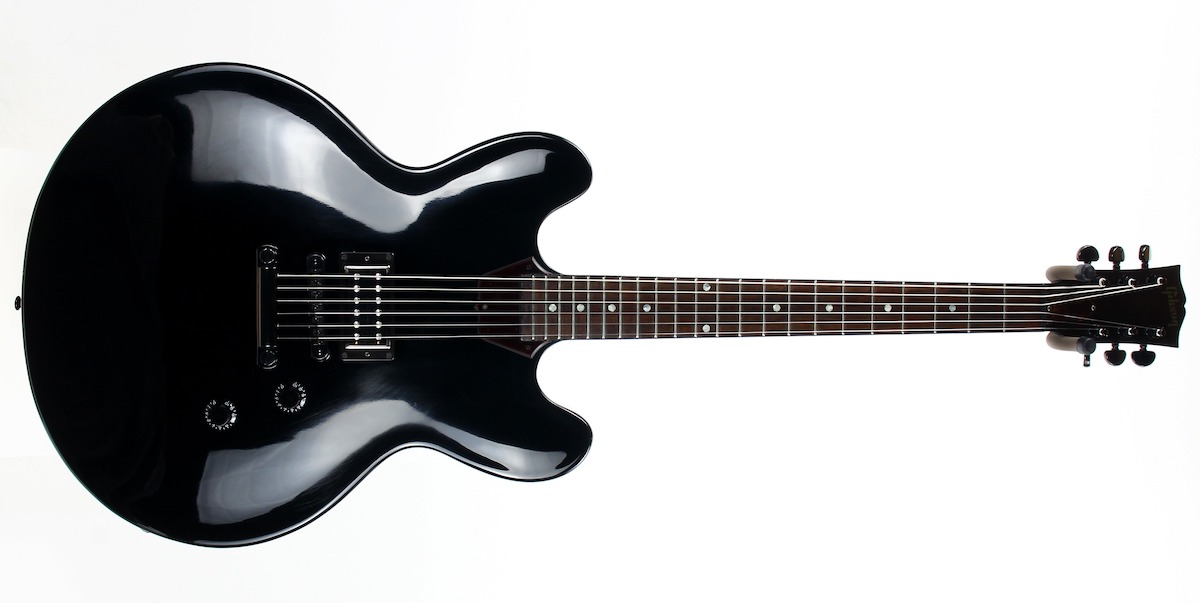
Budget 335-style model: At first (1986–91) without f-holes, two humbuckers, four-knob control layout (a.k.a. ES-Studio); two-knob version with single humbucker at bridge (2013); f-hole version, two knobs, two humbuckers (2014–19).
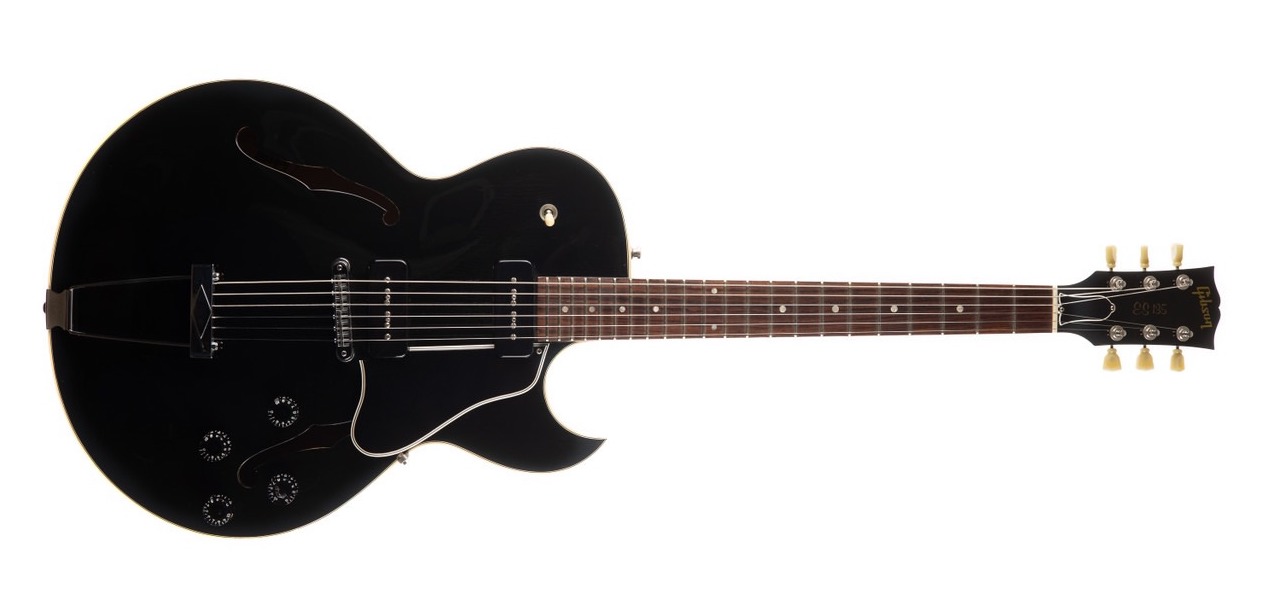
Single-cut model with internal balsa block: dot markers; two P-100 pickups (stacked-humbucker in P-90 case; regular humbuckers from '00; P-90s option '04); four knobs and selector on body front, jack on side; bridge plus trapeze (some with stopbar '03); some without f-holes ('03); some with gold-plated metalwork ('98–'99).
(These ES-135s should not be confused with Gibson's mid-'50s ES-135 hollow archtop electric.)
*Also: ES-135 Gothic (1998–2001) All-black version.
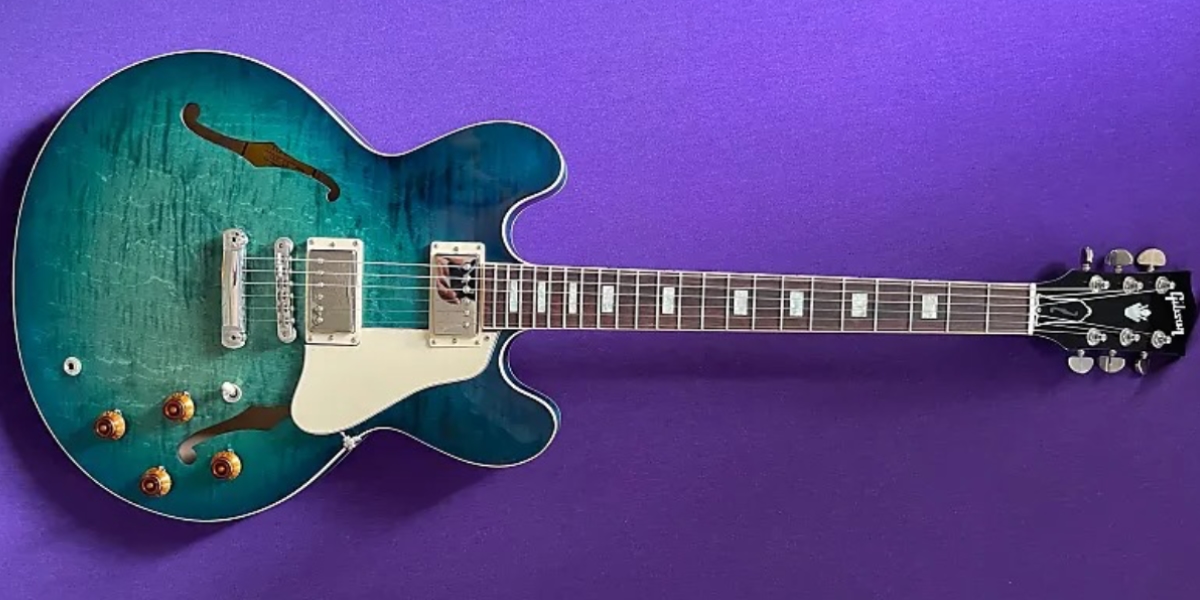
Reissue of second-era 335: small-block markers; four-knob control layout; two humbuckers; bridge plus separate stopbar. Made at Nashville 1998–2001, Memphis 2007–12, 2017–18.
Called ES-335 Block or ES-335 Block Inlay until 2012, ES-335 Traditional (2017–18). Memphis also produced year-specific block-neck 335s: 50th Anniversary 1963 ES-335TD Block VOS (2013); 1963 ES-335TD (2014–18). ES production reverted to Nashville during 2019 after Gibson closed Memphis.
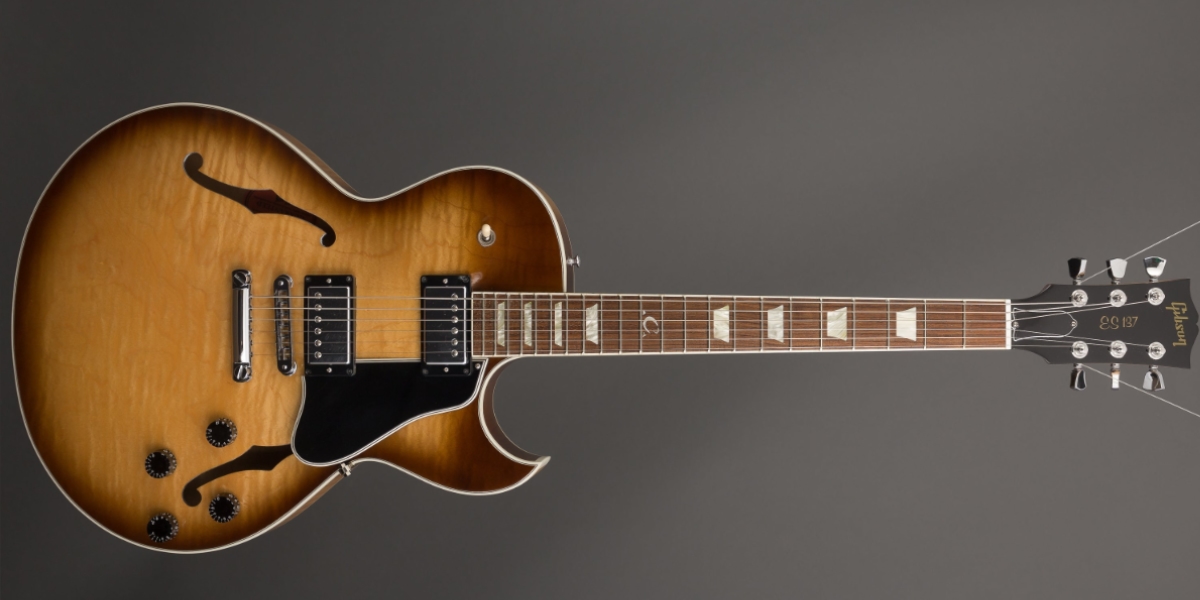
Single-cut model with 335-style internal mahogany block: Maple neck; crown markers; two humbuckers; gold-plated metalwork option.
*Also: ES-137 Custom (2002–11) Similar to Classic but multi-ply body top binding, figured wood, split-diamond markers, Varitone six-way selector; ES-137P/Premier (2002–03) Unbound fingerboard, mini-crown markers, humbuckers or stack-coils; ES-139 (2013) Without f-holes and pickguard, two knobs, one selector.
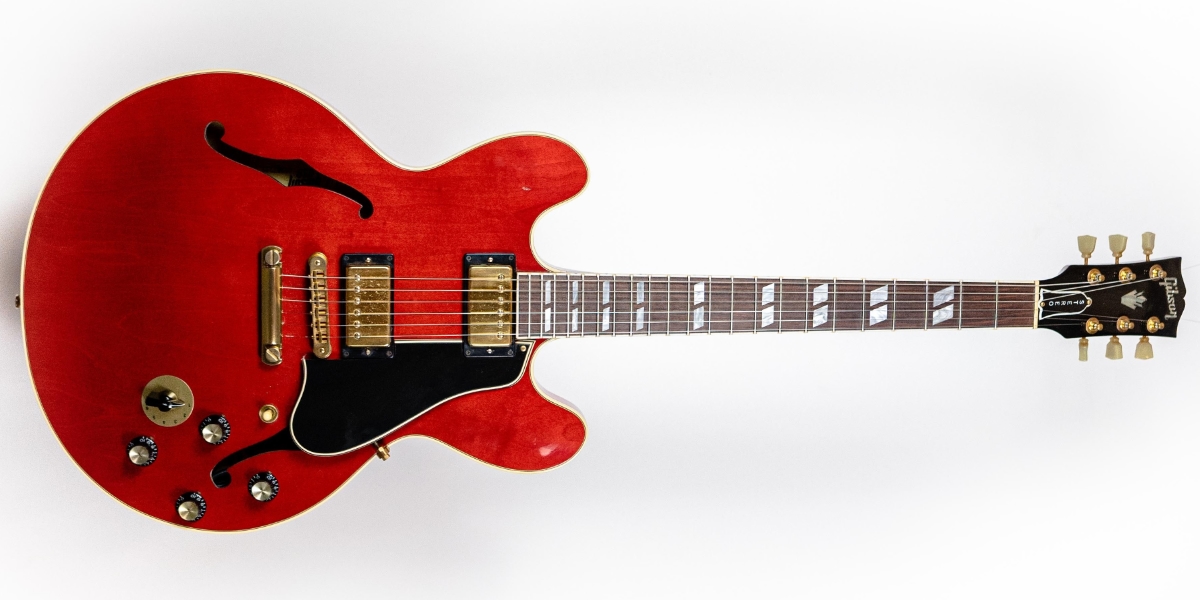
Starting in the early 2000s, Memphis made re-creations of the 345 with several options, including '59 and '64 styles. Today's version is mono and without Varitone, made now in the Nashville factory and part of Gibson's Original series.
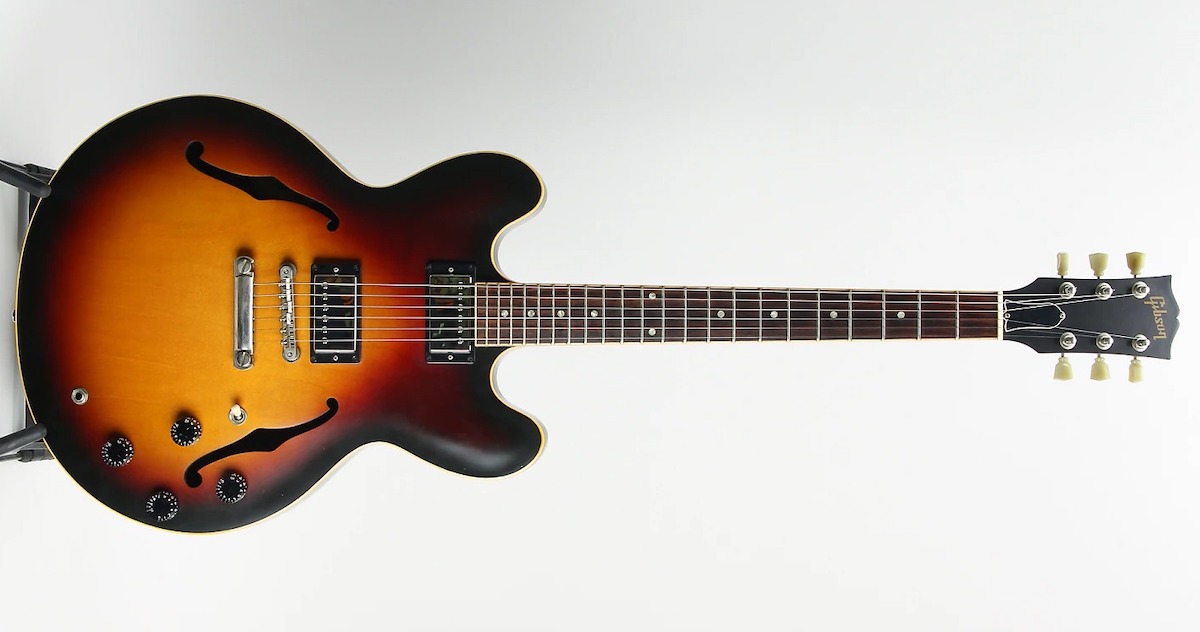
Stripped-down budget 335: Maple center-block; access plate on body rear; no pickguard; two humbuckers.
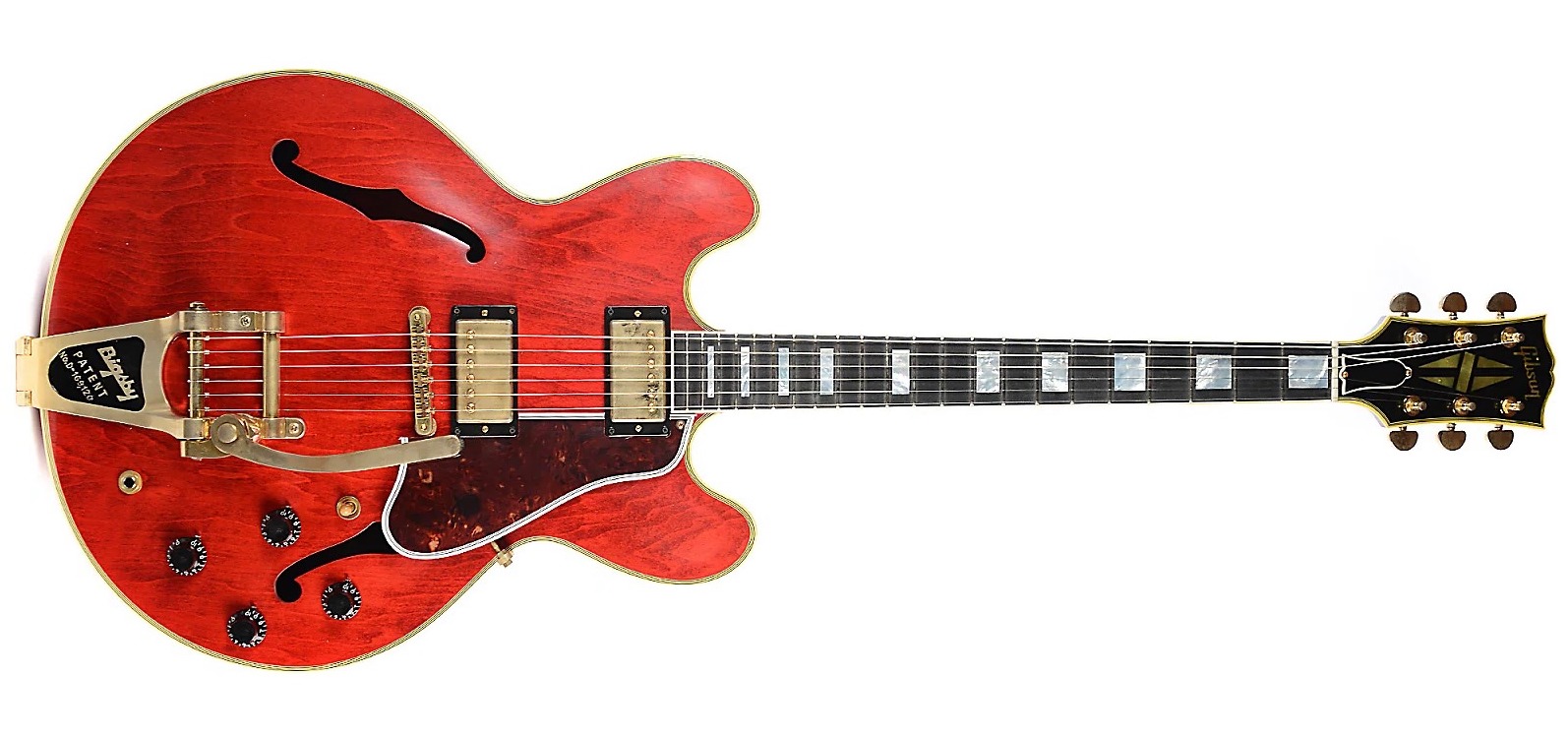
Memphis re-created the classic high-end 355 in several forms through this period, mono or stereo, with or without Varitone, most often with Bigsby vibrato, a version with P-90s, and more recently options for VOS or Gloss finishes and regular or Figured top.
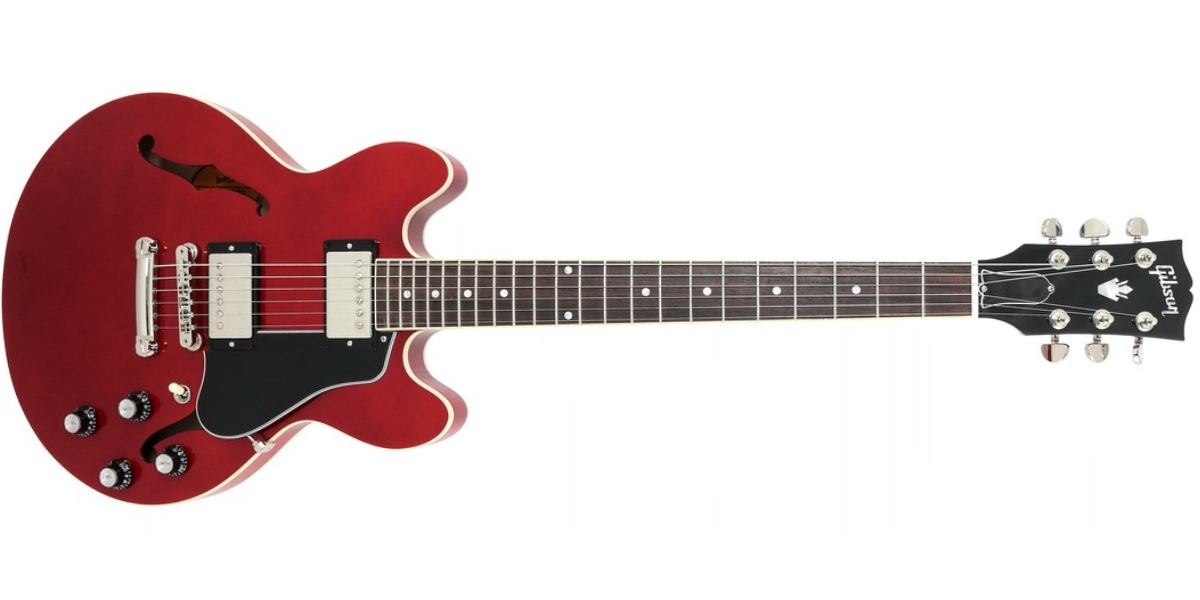
Long-running 335-style model popularizing smaller body: Hollow laminated body 14 1/4 inches wide with internal solid maple center-block; rosewood board with dot markers; four knobs (volume and tone per pickup) and selector on body front, jack on side; black pickguard; two humbuckers; bridge plus stopbar.
Later options for Satin or Gloss finish. Today, part of Gibson's Modern Collection, with regular or Figured top.
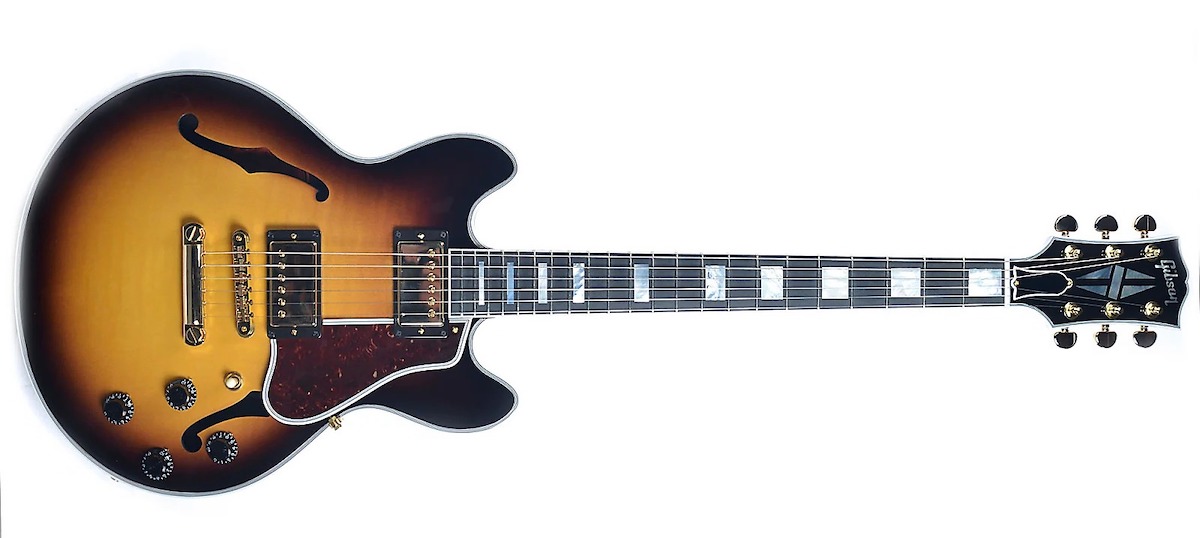
Smaller-body 355-style: Hollow laminated body 14 1/4 inches wide with internal solid maple center-block, multiple-bound top, bound back; ebony board with block markers; split-diamond inlay on bound headstock; four knobs (volume and tone per pickup) and selector on body front, jack on side; tortoiseshell pickguard; two humbuckers; gold-plated metalwork.
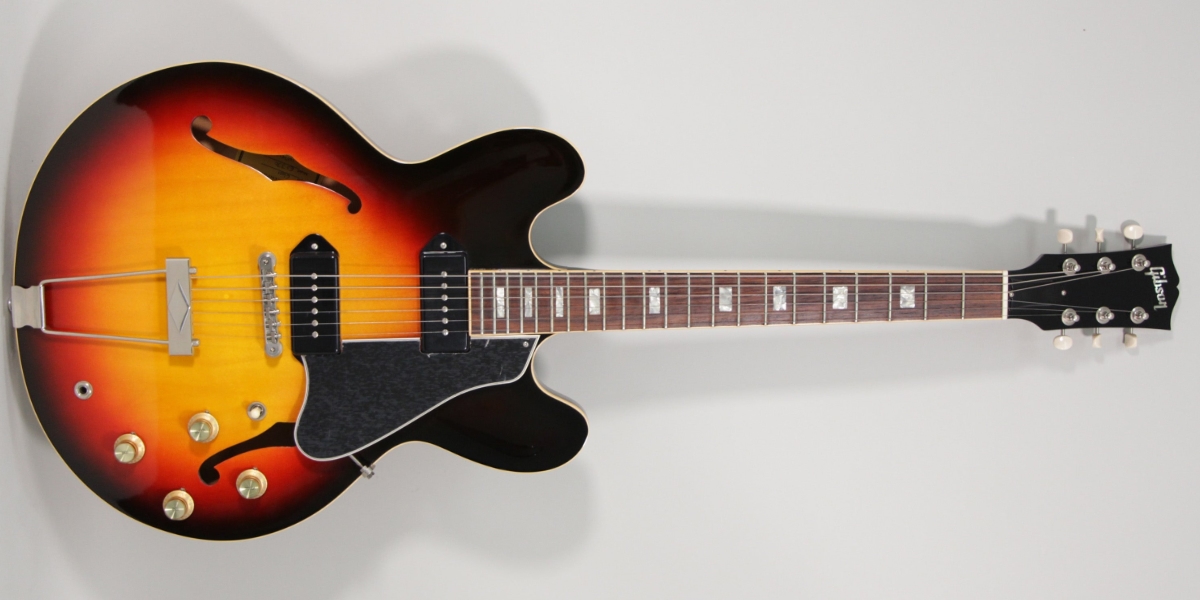
Through this period, Memphis re-created the fully-hollow 335-shape several times, as a '59 model with neck joining body at 17th fret, or in later "long neck" style with the junction nearer the 19th fret, along with other period-specific features. *Also: ES-330L Humbucker (2015) A hollow 335, or a humbucker'd 330?
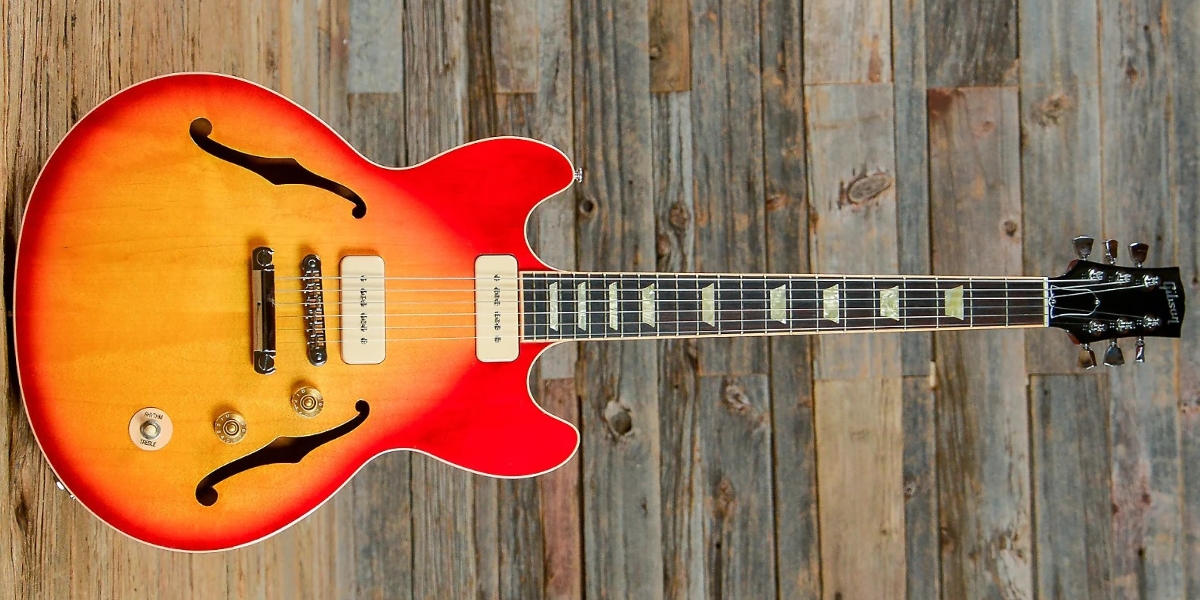
Small 335-outline body with routed construction: Body 13 3/4-inches wide with routed mahogany back and maple cap; some with access panel on body rear; crown or dot markers; two or four-knob control layouts; two P-90s, later two humbuckers; Nashville factory.
*Also: Midtown Custom (2012–14) Similar to Standard but block markers, split-diamond inlay on bound headstock; Midtown Deluxe (2015) Similar to Custom but higher-end features including quilted maple top.
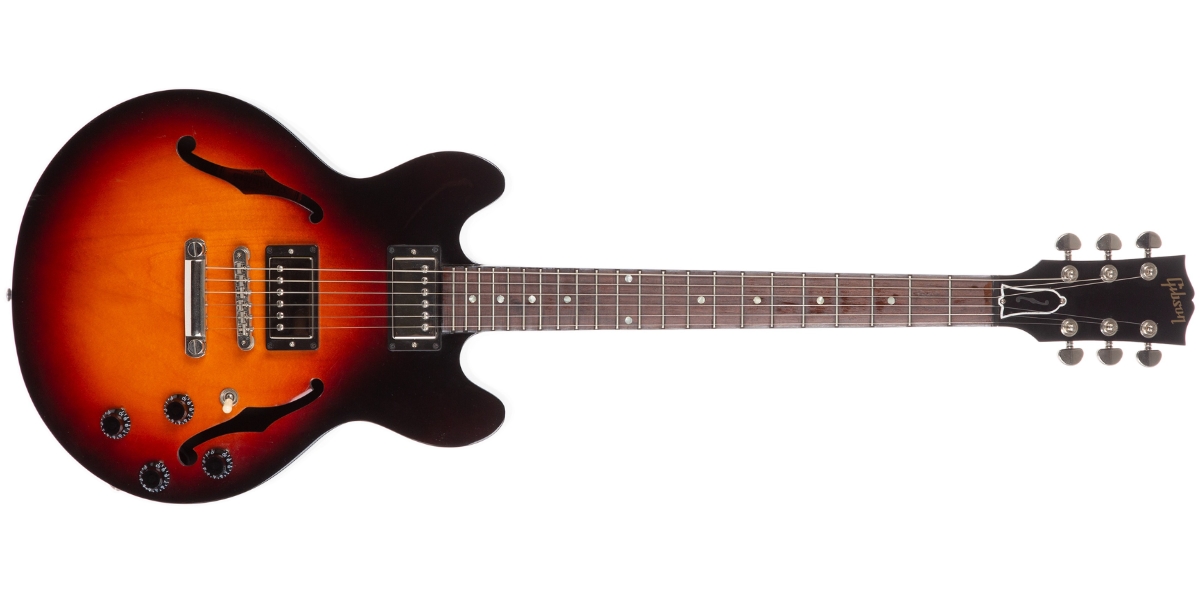
Stripped-back version of smaller-body 335-style 339: Main specs as 339, but unbound fingerboard with dot markers; two knobs (volume, tone) and selector on body front, jack on side (later four-knob); no pickguard.
*Also: ES-339 Studio single pickup (2013) One humbucker at bridge, no selector.
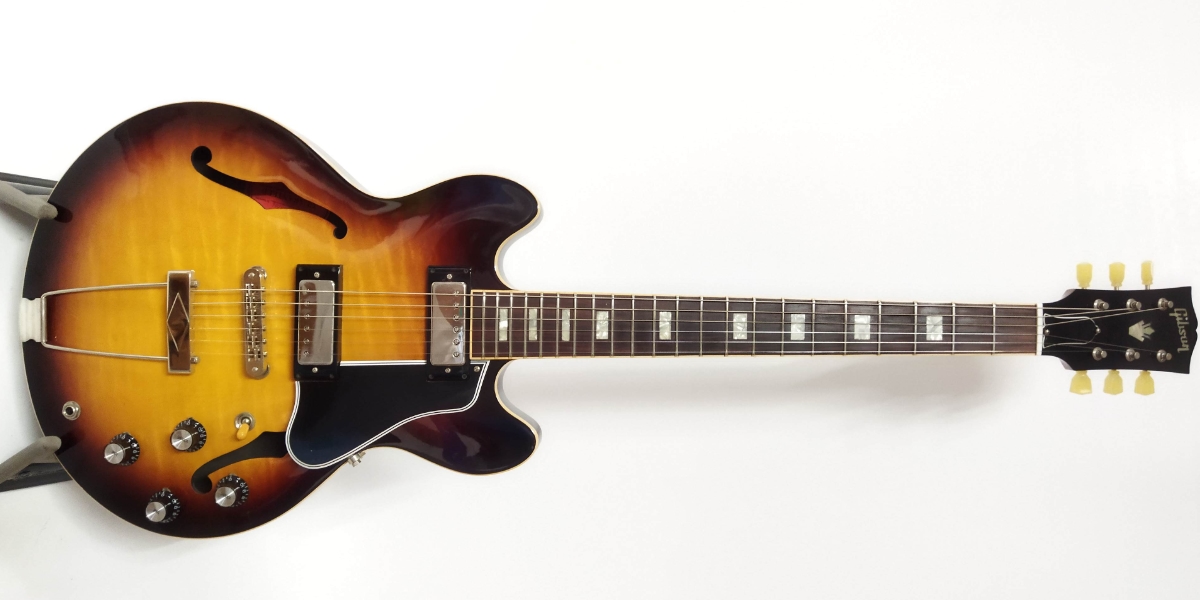
Smaller-body 330-style: Hollow laminated body 14 1/4 inches wide; small-block markers; crown inlay on headstock; four-knob control layout; two P-90s or mini-humbuckers; bridge plus separate trapeze tailpiece.

Les Paul shape with 335-style construction: Hollow laminated maple body 13 inches wide with internal solid maple center-block; crown markers; "Les Paul Model" on headstock; four knobs (volume and tone per pickup) on body with selector, jack on side; cream pickguard; two humbuckers; bridge plus separate stopbar or vibrato.
*Also: ES-Les Paul Custom (2015) Block markers, split-diamond inlay on bound headstock, black pickguard, two humbuckers, black finish; ES-Les Paul Black Beauty Similar to Custom but three humbuckers; ES-Les Paul P-90s (2015) Two P-90s. ES-Les Paul Gold Top P-90 w/Bigsby (2016) Two P-90s, Bigsby vibrato; ES Les Paul Special (2016) Dot markers, no pickguard.
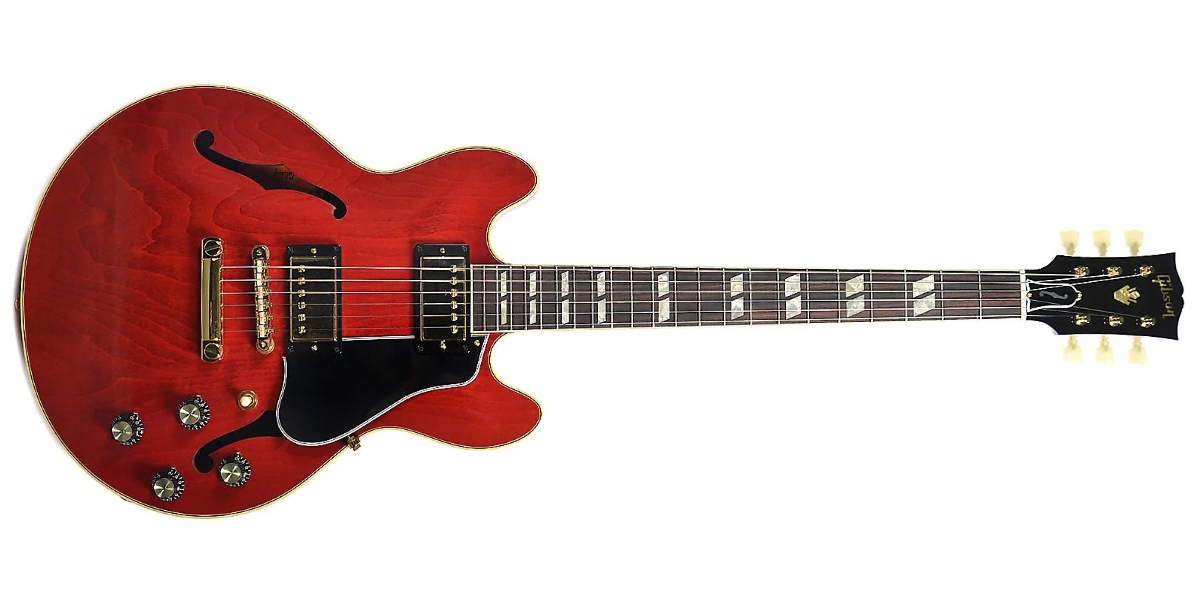
Smaller-body 345-style: Hollow laminated body 14 1/4 inches wide with internal solid maple center-block, triple-bound top, single-bound back; twin-angled-block markers; crown inlay on headstock; four knobs (volume and tone per pickup) on body with selector, jack on side; black pickguard; two humbuckers; gold-plated metalwork.
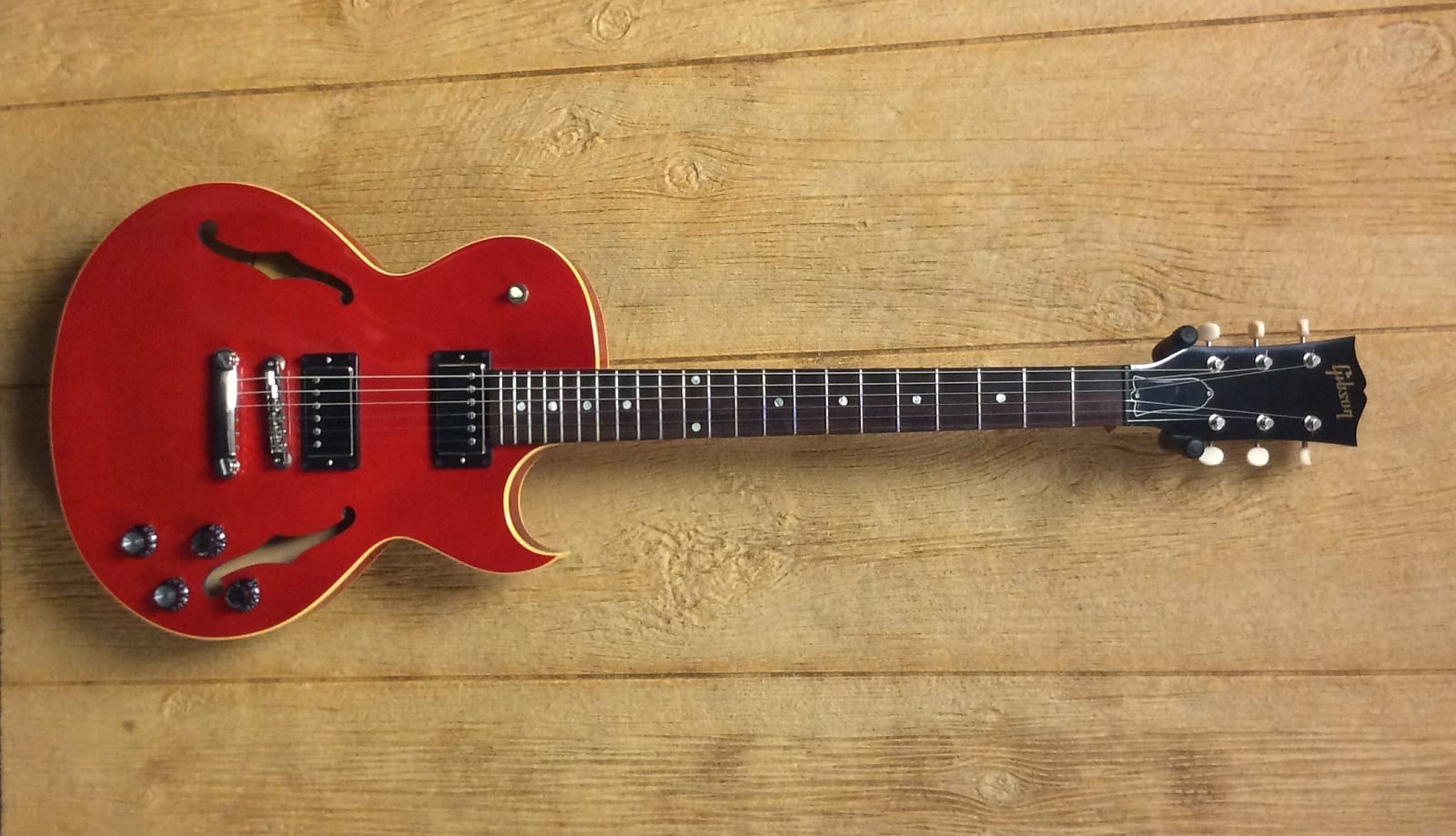
Single-cut model with 335-style internal maple block, referencing '90s ES135: maple neck; dot markers; two humbuckers; four-knob control layout; bridge plus stopbar.
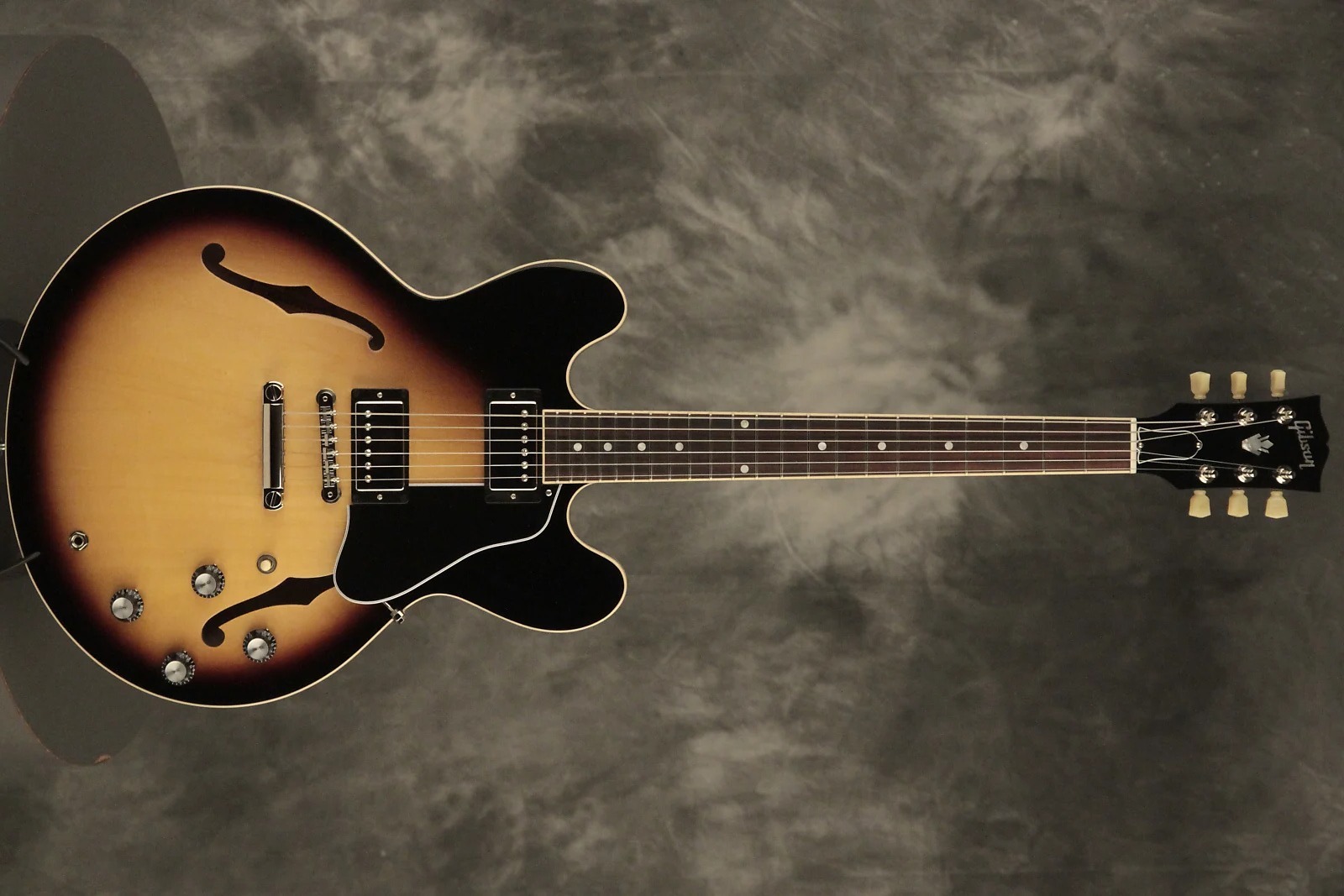
Under a new owner, Gibson simplified and settled its lines, including several ES models.
The revived 335, currently part of the brand's Original series, has classic features, including laminated maple body with maple center-block; mahogany neck; rosewood board with dot markers; four-knob control layout; shorter pickguard; two humbuckers; bridge plus stopbar; nickel-plated metalwork; options for regular or Figured top.
Today's Modern series 335, with wiring tweaks, has a Satin finish rather than the Original's Gloss.
About the author: Tony Bacon writes about musical instruments, musicians, and music. His books include The Gibson 335 Guitar Book and Electric Guitars: Design & Invention. Tony lives in Bristol, England. More info at tonybacon.co.uk.
